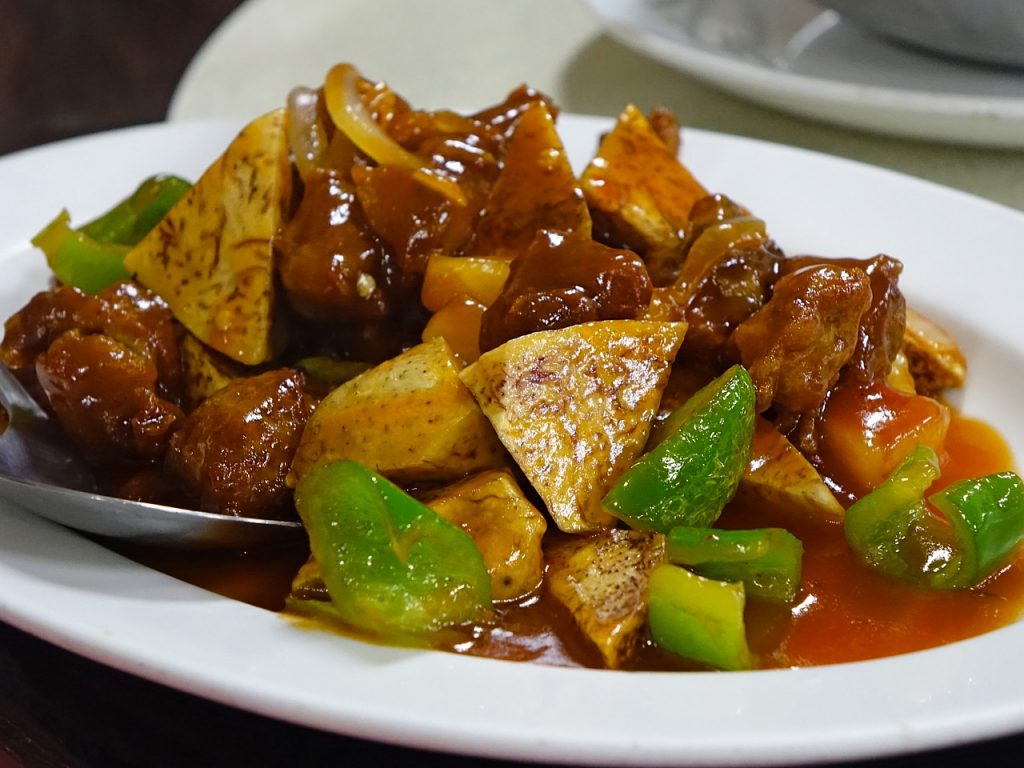
Can monosodium glutamate (MSG) actually cause gout? And, if it can, how do you recognize which foods and additives you would need to avoid? Here you’ll discover that MSG isn’t only used in East Asian cooking, you’ll also find it in a great many everyday foods, natural as well as processed.
MSG and Gout
Before we get into any potential link between MSG and gout, let’s first take a look at what it is, where you’ll find it, and any general health implications. I mean, if it’s bad for your health, you wouldn’t want to be eating it in any case, gout or no gout, right?
Monosodium Glutamate
Monosodium glutamate or MSG, as it’s more commonly called, is the naturally occurring sodium salt of glutamic acid, one of the most abundant amino acids in nature and a form of glutamate. It may surprise you to learn that it’s present in the human body as well as in most natural foods, particularly in high protein foods, such as meat, poultry, fish, milk, and cheese.
The man-made version of MSG was developed by Dr. Kikunae Ikeda of Tokyo Imperial University in 1908. He was trying to isolate and replicate the savory taste — he termed it “umami” (oo-mah-mee) — of an edible seaweed called “kombu” which was used as a base for a variety of Japanese soups and dishes to help enhance their savory flavors.
Dr. Ikeda was able to determine that it was the monosodium glutamate in kombu that helps to blend and enhance various tastes. He then developed and patented a process for manufacturing monosodium glutamate from wheat and defatted soybean.
Today, MSG is mass-produced from fermented cornstarch, molasses, sugar cane or beet. It’s so potent that even a very tiny amount will dramatically intensify the flavor of whatever food its added to, including low quality, cheap foods. So, from a commercial viewpoint, you can see why food producers and restaurant owners alike have been quick to adopt it.
But there might be a health penalty to pay for us consumers…
Health Implications of MSG
Although the FDA has designated MSG as “generally recognized as safe” (GRAS), there’s a small minority of people who report some short-term reactions to foods containing MSG.
Some of the reported symptoms include:
- hot flushes
- sweating
- heart palpitations
- facial pressure or tightness
- weakness
- fatigue
- nausea
- chest pain
- tingling or burning sensation on the face or other parts of the body
Some experts refer to this as “Chinese Restaurant Syndrome” (CRS) — a misnomer if ever there was one — or “MSG Symptom Complex”.
The reason it has been designated a “Syndrome” or “Complex” is that there’s no scientific evidence that definitively proves a causal link between MSG and these adverse reactions. In fact, placebo‐controlled trials have failed to demonstrate such a link.
Nevertheless, some people report that they have suffered adverse reactions within a couple of hours of eating foods with MSG. So something’s happening. It’s just that, thus far, it hasn’t been proven to be due to MSG in the food.
However, it’s true to say that there is some controversy within the scientific community about the health implications of MSG…
As well as CRS, some experts believe that MSG may also affect the heart, overstimulate the glutamate receptors, lead to cardiac arrhythmias over time, and may also be associated with eye damage, depression, obesity, and disorientation.
But, as mentioned previously, there’s little hard evidence of a causal link to MSG. And, the quality of research may leave something to be desired, according to “A Review of the Alleged Health Hazards of Monosodium Glutamate” by Anca Zanfirescu, et al, 2019, that concluded:
“Many of the reported negative health effects of MSG have little relevance for chronic human exposure and are poorly informative as they are based on excessive dosing that does not meet with levels normally consumed in food products. We conclude that further clinical and epidemiological studies are needed, with an appropriate design, accounting for both added and naturally occurring dietary MSG.”
Many of the studies that Zanfirescu reviewed were on mice and rats. But even those studies with human participants used doses of MSG far in excess of what would normally be expected in your average diet. For example, the average adult in the West consumes something like 13 grams of glutamate a day from natural foods and only about 0.55 grams a day from added MSG. And both natural and artificial sources of glutamate are metabolized by our bodies in similar ways.
So it would seem that man-made glutamate isn’t any worse than natural glutamate and we consume it in very small quantities compared with natural sources.
Nonetheless, those studies cannot be dismissed out of hand, especially when you consider that some experts stand by their contention that MSG can damage our health. So it’s important to be able to identify which foods contain MSG so that you can make an informed decision on your diet.
Foods that Contain MSG
Natural glutamate is found in various types of food items such as meat, poultry, fish, seaweeds, kelp, marmite, vegemite, soy sauce, fish sauce, dried shiitake mushrooms, miso, anchovies, sardines, green tea, cheese, and more. Glutamate is commonly found as glutamic acid in these food items.
There’s been a general perception that man-made MSG is only used in East Asian cuisine. This is wrong. It’s used in a wide variety of restaurants and fast food outlets as well as by food producers who use it in frozen foods, bakery products, breakfast cereals, crackers, canned vegetables, canned soups and broths, potato chips, canned vegetables, cured meats, sausages, sauces, condiments, seasonings, desserts, and a whole lot more besides.
As you can see it’s literally everywhere. So, given its possible health implications, it behoves us all to be able to identify it correctly. And that means always scrutinizing food labels, especially when you’ve been diagnosed with gout (more on that later)…
Labeling
The Food and Drug Administration (FDA) of the United States has designated MSG as “generally recognized as safe”. However it requires that foods containing added monosodium glutamate be listed as such on the packaging. It cannot be listed simply as “flavoring” or “spices”.
The label may indicate MSG, monosodium glutamate, or other synonymous, such as:
- monosodium salt
- monohydrate
- monosodium L-glutamate monohydrate
- monosodium glutamate monohydrate
- sodium glutamate monohydrate
- MSG monohydrate
- autolyzed yeast extract
- hydrolyzed corn & soy protein
In the EU, EFTA and some other countries that use the E-numbering system for food additives, MSG is designated as “E621”.
This regulation doesn’t affect food items where MSG occurs naturally. But these natural food items cannot claim “No MSG” or “No added MSG” on their packaging.
Okay, there may or may not be a direct causal link between MSG and those general health issues, but what does the science say about MSG and gout? Is it any clearer?
Can Monosodium Glutamate Cause Gout?
Gout is a type of arthritis that affects the joints, causing severe pain, swelling, redness, and tenderness. It’s an inflammatory disease that develops in people with high levels of uric acid in their blood. High uric acid can result in needle-like crystals of monosodium urate that get trapped in the joints and surrounding tissue.
Uric acid is a natural byproduct of purine metabolism, which purines exist in our body’s cells and in the cells of the foods we eat. Around 30% of the purines in our body comes from food we consume, so we have to be very careful with our diet.
But, insofar as MSG is “generally recognized as safe” in the population at large, it looks as though the same can’t be said about people, like you and me, with gout…
You’ll likely know that your mouth contains taste receptors for each of the four basic tastes: sweet, sour, bitter, and salt. This has helped our body determine which foods are likely to be beneficial and which may do us harm throughout our evolution.
What you may not know is that there’s a taste receptor for a fifth basic taste: umami, the “savory” taste…
Umami and Purines
According to an article published in The Journal of Rheumatology, in November 2013, our taste for umami is linked to a strong primal need for purine-rich foods. For reasons that are too complex to go into here, high blood uric acid levels had an important role to play in our survival as a species some 11 to 16 million years ago (the mid-Miocene period).
It stands to reason that our survival mechanism would have had a taste receptor to help us identify purine-rich foods. The authors believe that that taste was, and is, umami. They discovered that umami-rich foods are also rich in purines, for example, many natural foods within the meat, poultry, and seafood food groups are both umami and purine-rich.
But, although those primeval conditions don’t exist today, the craving for umami-tasting foods is still hard-wired in us.
So that something that helped us survive all those millions of years ago has become a health hazard for us gout sufferers today: the more umami-tasting food (MSG) we eat…the more purines we consume…the more uric acid is produced in the body…the higher the risk of gout.
And, to make matters worse, there’s another way that MSG can raise your risk of gout…
Many flavor enhancers, such as disodium guanylate and disodium inosinate, are often paired with MSG to help increase their overall flavor effect without increasing the sodium content.
Unfortunately for us gout sufferers this comes at a price: these other additives can combine with the MSG to metabolize purines and so increase uric acid levels in the blood.
How to Avoid MSG in Your Gout Diet
Luckily, if you’re already following a low-purine diet (or actively considering one) then the issue of naturally occurring MSG will resolve itself since a low-purine gout diet avoids all high-purine foods and only allows limited consumption of medium-purine foods. (Remember, umami-rich foods are, generally speaking, purine-rich foods).
But how do you avoid added MSG? This takes a bit more work and determination:
- Avoid all fast food outlets.
- Eliminate frozen dinners, ready meals, canned soups and broths, cured meats, sausages, snack foods, condiments, and blended seasonings, etc.
- Inspect the packaging for MSG and, if you’re unsure, give it a miss to be on the safe side.
- In restaurants always ask if a dish you’re considering contains MSG, including any sauces and seasonings. If it does try something else.
Conclusion
Although the general health implications of MSG may be disputed, the results are in for us gout sufferers: MSG raises the risk of gout and should be avoided or, at the very least, severely limited.



